Animated Life Writing
There was a time in my life when I was convinced that school was the greatest place in the world. I was told that there would be toys, friends, and games to play all day long—I was three years old. When the bus pulled up to my street corner on my first day of school, I was mortified to learn that my mother would not be joining me. I proceeded to clamp my hands around a nearby post and held on as tightly as I could. “Why are you doing this?” I screamed as my mother and the bus driver worked together to pry me free.
In its broadest definition, life writing is a primarily non-fictional literary genre concerned with personal narratives that favour the self or the individual (Kadar 5). These narratives take many forms, such as autobiographies, diaries, obituaries, social media posts, and any other conceivable form that allows a writer to share a lived experience—whether it is their own or someone else’s. Journalling, for instance, might be used as a tool for self-exploration, whereas a keynote speaker might include an anecdote to engage and move their audience. We do life writing all the time because it is in our nature to story the world. These seemingly minor vignettes about a life can inspire, prompt reflection, foster communities, and allow us to relive moments in time.
Yet, how do we craft lived experiences in ways that best communicate the images we have of them in our own minds? Text is one reliable method. After all, this introduction begins with plain text and delivers on the more salient aspects of my memory. A comic strip is also suitable in this case because it allows me to embody the incidents in illustrations. However, for me, the animated cartoon is appealing because it allows me to demonstrate the events unraveling in real time. Applying both sound and movement to this narrative allows my audience to witness the events as I remember them.
In this paper and in the accompanying video design project of the same name, I explore the emerging practice of what I term animated life writing. This concept is observed as an inter-genre and inter-media hybrid that unites the animated cartoon with the fragmented narrative styles observed in traditional life writing. I argue that animated life writing is part of a broader media ecology that is supported by graphic narrative theory, the field of study largely focused on the intersection between comics, graphic novels, and narrative theory (Gardner and Herman 3). Essentially, the value that we find in static, image-based texts like the graphic memoir is also present in texts produced for animation.
Since YouTube’s inception in 2005, user-generated content has greatly influenced the development of the Web 2.0 experience, normalizing the use of video sharing platforms and other social media. Along with tutorials, animal videos, and other user-driven content, some creators use these spaces to share personal anecdotes and connect with audiences with similar interests. It is for this reason that I recognize these digital platforms for their potential use in storytelling. Pioneers in the YouTube animation community like James Rallison, known online for his YouTube channel TheOdd1sOut, produce Storytime Animation content—animated short stories based on the creator’s lived experiences. Within the last decade, this visual style of storytelling has become more prevalent as more creators began sharing their life writing in animated form, with varying degrees of success. For example, at the time of writing this paper in Summer 2023, Rallison has amassed a total of 19 million YouTube subscribers since his first video publication in 2014.
In producing my video, I follow similar design practices to that of channels like TheOdd1sOut to experience the impacts and the drawbacks of translating my own lived experience into a cartoon. Animated life writing, as a practice of research-creation, allows me to document the very process of animation while negotiating its relationship with life writing, graphic narrative practices, and my own embodiment in the story that I share.
Graphic Narrative Theory, Graphic Memoirs, and Animated Life Writing
Producing animated content from lived experiences is not a new concept. In fact, Channel 4’s 1989 stop-motion animation series Creature Comforts used Claymation to animate interviews with ordinary people about everyday things. However, these videos would have been a significant financial burden for most general enthusiasts because they involved professional animation studios and a television network for distribution. The material practice of animated life writing by ordinary people is a more recent phenomenon due to the growing access to digital environments, tools, and software over the last few decades. Over time, individuals began to occupy all roles of production including producer, writer, director, and even animator. Although this invites countless innovative methods for storytelling to emerge, narrative and comics studies have long been converging to offer us the theoretical toolkits required to engage with previously unrecognized hybrid forms of communication, such as personal narratives that have been animated. Specifically, this paper contributes to the ongoing expansion of scholarly interest in image-based storytelling: the field of graphic narrative theory (GNT). GNT is concerned with the intersection of text and images as they relate to, and deviate from, traditional narrative studies. Applying criticism from the converging fields of comics studies and narrative theory, GNT looks to texts that employ the methods of text and illustration, such as the graphic memoir, and considers the implications that these combined approaches have on meaning making (Gardner and Herman 4). Put simply, GNT considers the hybridity of text and images in texts like comics and the graphic memoir, and how these two distinct media are used in tandem to share compelling stories. What we gain from these observations is a heightened understanding of the relationships among readers, writers, and their respective engagement with the stories in question. By expanding our corpus to include other, intersecting forms of visual storytelling like the animated cartoon in animated life writing, we can more readily recognize unconventional, yet faithful, productions of life writing that inhabit our print and digital spaces in unique and unexpected ways.
In general, when we read a memoir in print or digital form, there is no question that we are, in fact, reading a memoir. But when we break the structure of these texts and deviate from their traditional modes of delivery, we are met with observations that complicate our understanding of what a text is. The use of illustration in the graphic memoir, for instance, was at one time a deviation from the traditional memoir, but we now champion it for its ability to supplement and replace written words in ways that amplify their meaning (Quesenberry and Squier 73). If we look to animated life writing as simply another mode of storytelling, then we will undoubtedly see the works of memoirs in motion.
Essentially, the practices that we apply to static, image-based narratives like comics and the graphic memoir are also distinguishable in the production of animated life writing. GNT argues that image-rich modes of communication heighten the accessibility of personal narratives and, consequently, render them more relatable. As demonstrated by their successful execution of graphic narratives, practitioners such as blogger turned graphic memoirist Allie Brosh quite literally illustrate the affective power of visuals and imagery in their adoption of this style of life writing. In her debut graphic memoir Unfortunate Situations, Flawed Coping Mechanisms, Mayhem, and Other Things that Happened, Brosh illustrates her experiences battling anxiety and depression. In a particularly poignant scene, Brosh describes depression as an emptiness rather than a sadness: “it’s not really negativity or sadness anymore, it’s more just this detached, meaningless fog where you can’t feel anything about anything—even the things you love” (Brosh 128). The scene is accompanied by Figure 1 and 2 in which Brosh’s crudely drawn avatar navigates the darkness while being beckoned by a voice that represents her experience with depression.
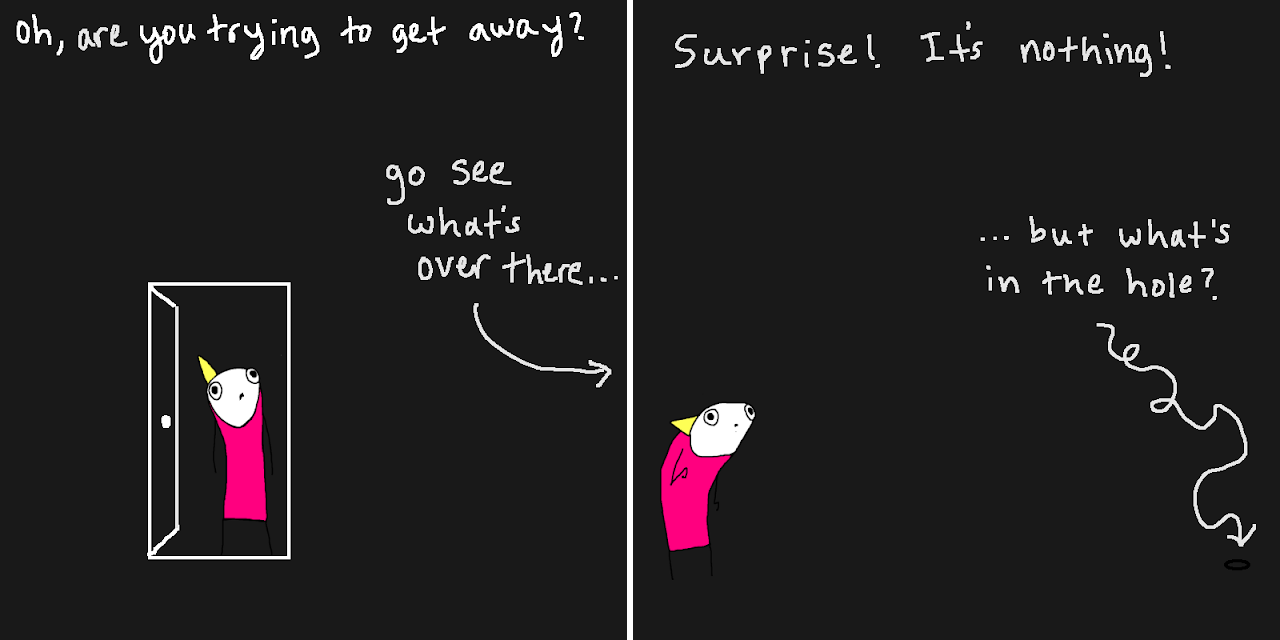
(Brosh 2013).
The illustrations in Figures 1 and 2 conceptualize the “detached, meaningless fog” to give it a form that is more readable for an audience that cannot relate to Brosh’s experience. As with all texts in this medium, the “combination of words and images produces a hybrid form able to represent narrative and materiality simultaneously” (DeFalco 225). Ultimately, illustrations in graphic memoirs offer the writer the opportunity to represent themselves and to demonstrate abstract concepts like love, despair, and longing in ways that are complicated by the written word.
In considering the work by YouTube animation channels like TheOdd1sOut, it is evident that what makes the graphic memoir effective also emerges when the life writing is animated. These video styles apply graphic narrative practices such as sequential art and captioning but with the additional advantage of sound and movement design as afforded by digital video. Therefore, the greatest benefit of animated life writing is observed in its treatment of time. Unlike the graphic memoir, which is restricted to panels in a static space, the animated medium demonstrates changes as they unravel along a timeline.
Animated life writing, in its broadest definition, is the product of any life writing genre presented in animated form. While the examples that I engage with in this paper are anecdotal stories and represented in 2D animation, there is no restriction to how a creator may envision their experiences. For example, in his publication “Animated Autoethnographies: Stop Motion Animation as a Tool for Self-Inquiry and Personal Evolution,” Jeremy Michael Blair establishes stop motion animation as an emerging method for personal inquiry and self-research. Using this style of animation, creators are empowered to critically reflect on past experiences, “enter empathically into the lives of others, and actively participate in dialogue regarding the social implications of the encountered” (6). To this end, the styles of animated life writing can vary greatly, much like how the styles of the graphic memoir will differ from one author to the next. Ultimately, those with greater exposure to video sharing platforms like YouTube are far more likely to come across animated life writing than those who do not engage with similar platforms. It is perhaps for this reason that our current scholarly spaces seldom recognize the use of the cartoon beyond comics. If this is the case, then I invite scholars and practitioners to further investigate this area of storytelling as I have done with my video design project.
Video Design Project
The objective of this project is to apply—and mediate the very processes of applying—graphic narrative design methods to the spatial and temporal elements of animation to enrich our understanding that these creative communications can also be critical approaches. The project takes the form of a six-minute animated video, and it examines the relationship between graphic narrative theory and the practice of cartoon animation. In doing so, it intends to justify the medium of animation as an effective form of storytelling while also contributing to the community of animated life writing. The video begins with an original story time animation in which I narrate an early childhood memory about a tobogganing experience with my family. It is followed by an informative animatic that explores GNT in the context of content animation.
Like Mary Vertulfo in her 2018 thesis Animating from the Margins, I consider animation an underexplored medium of life writing in which GNT directly applies. I propose that the elements that render the graphic memoir more accessible than traditional autobiography also apply to animated life writing. Essentially, this project offers a unique opportunity to document the production process of animated personal narratives and the impacts of this medium on the final product. I will expand on this by first exploring our existing practices of life writing and its developments in the digital video arena. As my video design project suggests, the application of sound and motion in the animated medium offers new methods of embodiment—how writers represent themselves and occupy their narrative spaces—in life writing. These tools enrich our personal narratives by doing what the term “to animate” intends: they imbue the inanimate with life.
Just like any other medium of life writing such as the graphic memoir, life writing narratives are not restricted to a specific type of story. When I refer to the graphic memoir as an example of life writing, I do so to bridge the gap between traditional text-based life writing narratives as seen in the memoir and the highly dynamic and multimedia form of the animated cartoon. The visuality of graphic memoirs and comics allow experiences to not only be read but also seen. Thomas Couser states that “in the print medium, the body is not ‘there’ on the page to be seen. It may be described in some detail, and the reader may form a mental image of it, but that image is not literally inscribed by the author” (349). Graphic narrative scholars make a point of highlighting the relevance of representation in life writing, since traditional print fails to capture the nuance observed in illustrations. As Amelia DeFalco observes, images have the capacity to draw attention to ideas and meanings—such as vulnerability and passion—that may otherwise be lost on the reader (224). Animated life writing takes this concept a step further and adds sound and movement to capture faithful accounts of the lived experience. When animated, the detail observed in a graphic narrative’s illustrations is imbued with life that is not as accessible in static texts. Where the body is concerned, the medium of animation will be of specific interest to life writers for its ability to incorporate gestures and other dynamic expressions via sound and movement.
However, the ideal methodology for representing a body in images is a noticeably subjective matter in scholarship. Which is more effective: highly realistic images or the universally accessible approach of the cartoon? Where Couser sides with the style of realism for its ability to represent its subject more accurately, Scott McCloud’s Understanding Comics illustrates a variety of representational styles in graphic narratives including universalism, arguing that the accessibility of concepts can be amplified through simplification (Couser 356; McCloud 30). Specifically, McCloud posits that the cartoon adds appeal and is much more readable for the audience when compared to realistic sketches. McCloud’s text suggests that due to our limited self-awareness, in the sense that we can never fully see ourselves in the way that we see others, we can relate with a less vivid/realistic rendering of a human. Simply put, “when you look at a photo of a realistic drawing of a face you see it as the face of another. But when you enter the world of the cartoon, you see yourself” (36). While realistic imagery allows authors to represent themselves with more precision, universal approaches that abstract characters and settings are likely more relatable simply because we as readers can insert ourselves into the narrative. As practitioners like Brosh have demonstrated with their graphic memoirs, often representing their self in less vivid ways, it is not necessary for the body to be represented by realistic figures for the reader to understand the text. It is therefore reasonable for these assumptions to carry over into the narrative after it has been animated.
Comics and Cartoons
There is no question that comic books, graphic memoirs, and any other visual medium are distinct, respectable, and effective communication tools1. Each mode of delivery offers a unique approach to storytelling and may even favour specific types of narratives as determined by their author. Until now, I have observed overlapping characteristics between graphic narrative theory and life writing, especially when the graphic memoir is concerned. In truth, it is not surprising that the memoir has become such a focal point in my studies of graphic narratives and animated life writing. Specifically, the memoir presents certain creative freedoms that are not present in other life writing genres, like the biography, in which the author is often encouraged to remain objective (Kadar 4). For instance, often indicated with a change in font, memoirists will fill in narrative gaps where their memory of a specific event may be incomplete. This offers writers the liberty to explore literary devices such as irony, hyperbole, and foreshadowing with greater effect. It is likely for this reason that the content by creators like Rallison so often appears to exhibit memoir-like qualities.
In this section, I investigate the animated life writing content that inspired the accompanying video design project, with a particular focus on the similarities relating to static, graphic narrative practices. After all, animation is a communication medium that employs the approach of comics (McCloud 21). If the use of images in the graphic memoir renders it more accessible than traditional autobiography, then surely the same holds true for the cartoon. Keeping in mind that there are clear distinctions between animation and print media, further consideration is given to the liveliness and relatability of an author’s animated avatar and their contributions to the parasocial relationship.
In understanding the benefits that images have on life writing narratives, it seems almost intuitive to make the leap into the Storytime Animation genre with which many YouTube content creators often engage. The success of Rallison’s channel TheOdd1sOut demonstrates the continued popularity of life writing narratives among younger audiences. While the channel’s chosen medium is distinct from the graphic memoir, some of Daniel Merlin Goodbrey’s seven key characteristics of comics—space as time; simultaneous juxtaposition of images; closure between images; spatial networks; reader control of pacing; tablodic images; word and image blending—are still present in the final product (44). As a case study, examining this YouTube channel makes it possible to identify some of these characteristics within popular animated life writing. It also offers the opportunity to investigate the distinct features of animated life writing that contribute to its appeal. In the final installment to his work experience series “Sooubway 4: The Final Sandwich,” Rallison explains that the positive response to his cartoons was widely unexpected:
“[My previous workplace] will always hold a special place in my empty heart. Not because I have fond memories working there but because some of you really liked it when I talked about working there […] Apparently, I was hashtag-relatable enough to connect with millions of people and it took my channel to where it is today. And then less than two weeks later, I made a part two to that video and I struck an even bigger chord with people.”
Ultimately, the animated life writing narrative is another creative way for storying the world. The use of movement and sound produces a certain liveliness that viewers otherwise need to envision and process themselves when reading static texts. Regardless of the formal styles used to craft the animated narrative, the cartoon requires less effort from its viewers to deliver a representation of a life. Similarly, the labour involved in crafting these narratives, while time consuming, grants greater autonomy over their production. As an alternative to incorporating external resources like actors for live-action video, or navigating the obstacles in print publishing, animated life writing is a craft that creators have the option to engage with independently.
While movement (or the perception of movement) is a key characteristic of animation, animated life writing relies on a combination of visual styles to tell a story. For instance, it is common for creators like Rallison to hold a frame for several seconds, emulating a comic panel, for any number of reasons. A still frame can be used to emphasize the actions in the scene, and it can also be a strategic choice to save on production time and resources. Given the variability of animated life writing and the contrasting definitions of what comics are, it is possible that comics studies relate to this field with greater applicability than I suggest. For this paper, any comparison between comics and animation is based purely on form. For example, a graphic memoir—which applies the approach of comics—can be assessed against a TheOdd1sOut video for the purpose of examining the use of space and time in both artforms. While both Goodbrey and McCloud identify the distinctions between the art of comics from the cartoon, we may find considerable overlap in what Goodbrey calls tablodic images (44).
Drawing from the concept of the tableau, Goodbrey describes tablodic images as “the artwork in a comic […] deliberately composed, framed and illustrated to represent key moments of narrative meaning” (56). The tablodic image frames the contents of a graphic narrative into a readable image that reinforces the linguistic message. We often see this feature in animated life writing, especially when carefully constructed backgrounds are designed to fill the screen space and contextualize narrative beats, composing a scene or, rather, a complete picture that complements the narrative. In the case of TheOdd1sOut, the framing and object placement in its image-rich videos offers the viewer additional context into the life of the creator. In his work experience video series, Rallison regularly fills static frames with strategically posed avatars that depict employees either interacting with customers or making sandwiches. These framed instances are also used to complement the emotional energy present in the narrator’s voice as observed when difficult customers overwhelm and frustrate the workers. Theorists Krista Quesenberry and Susan Merill Squier have made similar observations when relating comics practices to the graphic memoir, stating that “the visuals of the comic underscore the realism of a character’s experience, in addition to (and often in contrast with) the verbal expressions that may also appear either inside or outside of the frame” (82). Not only is the tablodic image an effective practice in comics, it proves to work in tandem with sound to emphasize something of significance such as shock and excitement. For instance, when Rallison describes the experience of receiving a forty-dollar tip while working part-time at a sandwich shop, he expresses it with his voice and illustrates it with his cartoon avatar’s body language on the screen (see Figure 3).
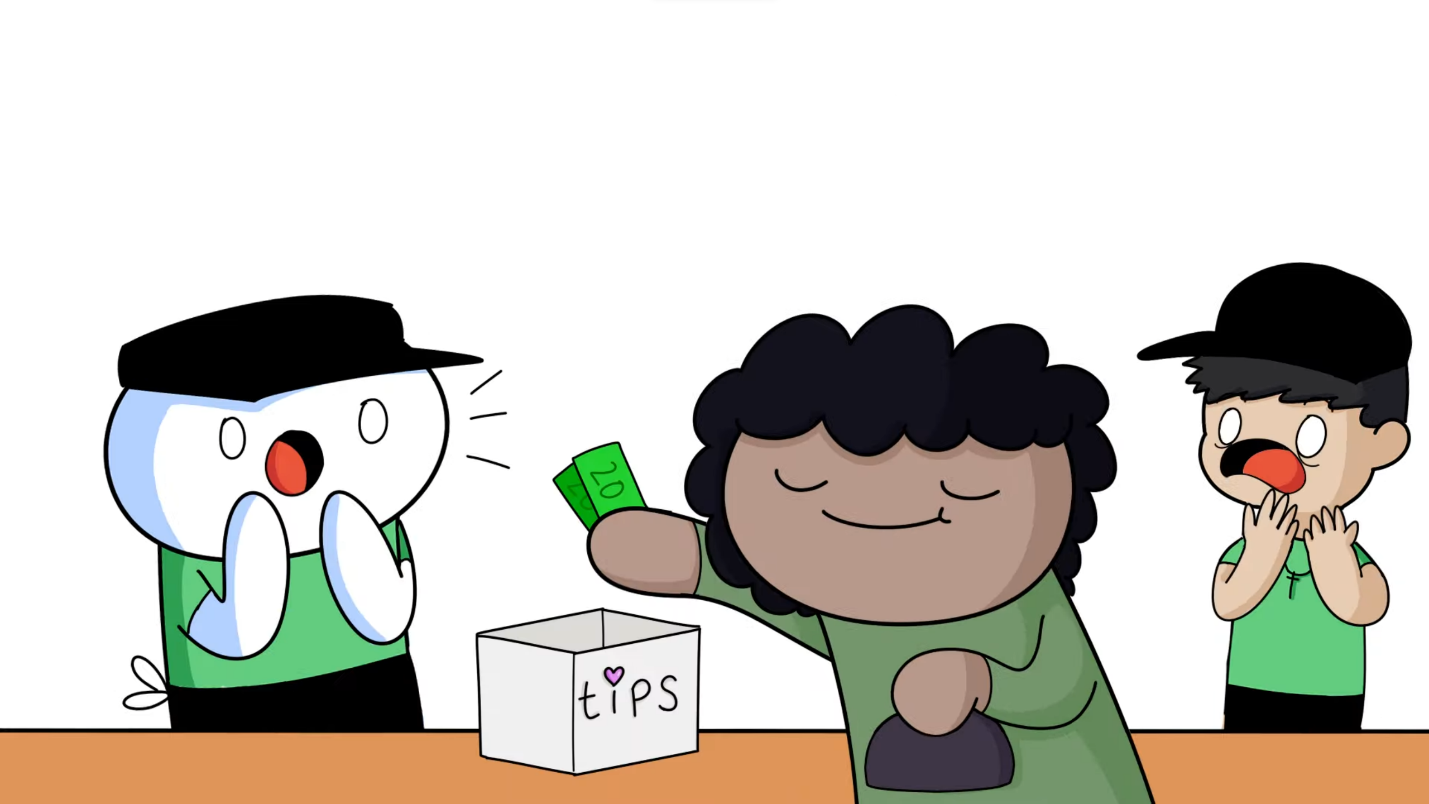
Visually, the approach of comics is clear in channels like TheOdd1sOut because the videos favour an animatic style that uses limited movement when representing moments and actions. For instance, the images are clearly drawn, and the scene composition may, at times, include the use of panels and words with time allotted for viewers to process the images. These elements are distinguishable as Goodbrey’s characteristics of juxtaposition and spatial networks. It is true that animation is a collection of images in sequence that when filling a frame in rapid succession create the illusion of motion, but this sequence is, nonetheless, “sequential in time” rather than in space like traditional comics and the graphic memoir (McCloud 7).
However, even when animated life writing does not incorporate panels, there is still one panel that is always in use: the video’s frame. Considering the gestalt concept of closure which McCloud defines as the “phenomenon of observing the parts but perceiving the whole,” we recognize that viewers can look at a comic panel and understand that parts of the narrative exist beyond what is made visible (63). For instance, in the TheOdd1sOut work experience video series, there are instances when Rallison’s avatar is cut off at the waist by the video’s frame (see Figure 4). Despite the absence of legs, we instinctively commit closure by understanding that legs continue to exist beyond the physical border. Mentally, we account for the missing legs whether there were ever any drawn during the production process. Despite the absence of multiple panels and gutters, it is evident that the animated cartoon takes advantage of our ability to commit closure by removing elements in exchange for more appealing compositions.
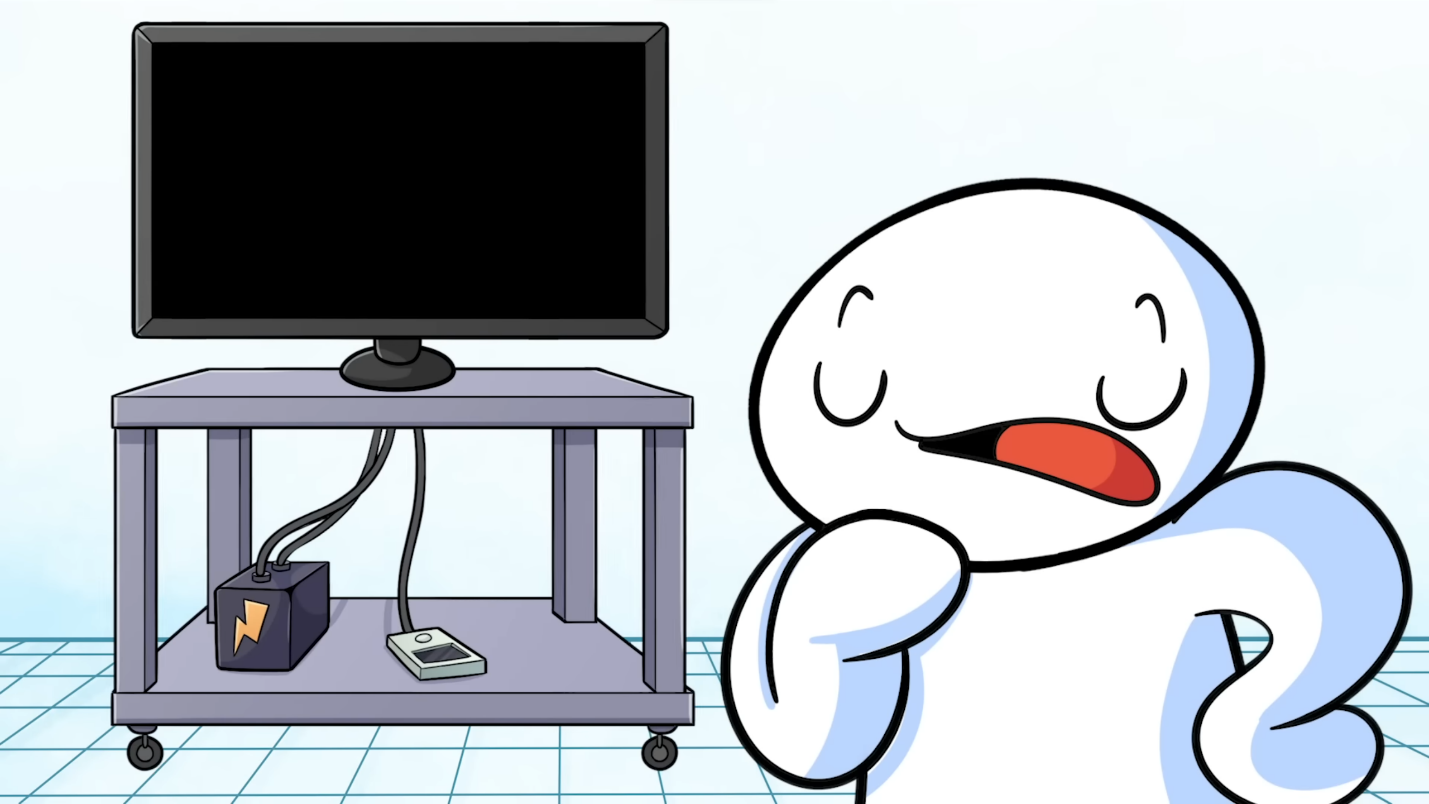
The Liveliness in Animation
Time and space operate differently between print and animation. Both media are unique communication tools with the capacity to tell compelling stories, yet they rely on similar mental operations to convey them. Where I suggest that these artforms differ the most is in the degree to which a viewer’s cooperation is required to establish a sense of liveliness in the respective text. As McCloud argues: “Just as pictures and the intervals between them create the illusion of time through closure, words introduce time by representing that which can only exist in time—sound” (95). When reading comics, we as readers instinctively incorporate time and sound into the narrative. We do so because images provide a framework through which we impose our own experiences and knowledge of the physical world onto the narrative. But when we enter the cartoon, these mental processes are not as necessary for understanding the full picture. Specifically, in animation movement occurs within one panel (the video frame) and diegetic sound captures the sonic actions happening at each layer of the scene, guiding the viewer through one seemingly fluid series of incidents before their very eyes. The narrative design for these videos is less concerned with the audience’s ability to interpret meaning since the qualities of time-based media—the presence of movement and sound—are already very much a fundamental aspect of their reality. Essentially, less autonomy is given to the viewer, and it is perhaps for this reason that the illusion of life in the animated medium is so convincing. Animated narratives provide an immersive experience that take the inanimate, no matter how abstracted (consider the avatars from TheOdd1sOut or Allie Brosh’s Hyperbole and a Half), and make it walk, talk, and think (Williams 11).
What distinguishes static illustrations from the moving image of the cartoon is that “the role of the vector is taken over by movement” (Kress and Van Leeuwen 258). For example, audiences no longer rely on carefully crafted poses to interpret character actions, because movement is used to create these very actions. An animator’s efforts to design movement in their narrative effectively reduce the viewer’s processing time in exchange for greater focus on the story that it tells. This is not to say that the animation style must be comparable to a major Hollywood production to be understood. After all, Gunther Kress and Theo Van Leeuwen recognize the liveliness of simple stick figure animations:
“[M]ovement can be represented with different degrees of realism or abstraction and hence play a role in modality judgements. Representations of walking, for instance, can range from simple animations in which stick figures raise and lower their legs without any articulation of the joints or any movement of the rest of the body, to highly detailed animations showing the rippling of every muscle involved.” (264)
The content of animated life writing narratives as observed in the TheOdd1sOut’s work experience series might favour an animatic style of animation with limited motion, but this has no bearing on their ability to effectively represent a life.
While time-based media provide the means for change to occur over time, thereby employing the illusion of movement, sound is perhaps the strongest argument for the liveliness in animation and animated life writing narratives. After all, content by creators like Rallison, whose animatic style resembles digital comics, favours the narrator’s voice when recounting lived experiences. Paul Taberham suggests that “audio operates like an echo of the physical world in an otherwise constructed landscape. The sonic space may be highly referential, resembling the sound of the natural world, or it might be ‘hermetic’” (131). Much like the use of illustrations, the channel of sound creates meaning. It describes the environment, using foley to represent the relationships and networks that exist in the narrative. It can create a sense of anticipation, such as when the creak from an off-screen door is heard. Naturally, we might assume that someone or something has opened the door and await the reveal. However, sound can also be present in the form of emotional inflection, describing how a character is feeling or intends to be received. In the case of animated life writing where the author narrates their own experiences, they can also manipulate space and simulate intimacy simply by speaking closer into their microphone, allowing for deeper tones and imperfections to be registered in the audio recording. As a result, these more intimate narratives will create what can be perceived as a personal interaction without the speaker and viewer ever truly interacting. In narratives like “Sooubway 4: The Final Sandwich,” the author’s voice is observed as speaking directly at the viewer, contributing to a much more intimate reading of the text than if the narrative been delivered in print form for the reader to interpret. Simply put, a soundtrack with spoken dialogue leaves less opportunity for misinterpretation.
From Script to Screen: Project Methodology
Wojciech Drąg quotes Paul Ricoeur, stating: “We understand our own lives—our own selves and our own places in the world—by interpreting our lives as if they were narratives, or, more precisely, through the work of interpreting our lives we turn them into narratives, and life understood as narrative constitutes self-understanding” (224). Writing our lives is, then, an intimate activity that takes on many forms in the pursuit of authentic representation. Just as words in print media can convey meaning beyond the written text—in that “there are silences, gaps, which communicate” more than we can know—the moving pictures in the cartoon render these invisible communications more accessible, providing an opportunity to show what is difficult to tell (Dewsbury 151).
What I found in producing my own original animated life writing was a greater capacity to represent my memory in a manner that more accurately captures how I wish for it to be perceived. There is no question that my use of hyperbole is anything but that. For instance, my sister never blew a kiss at our father before our descent down the hill (see Figure 5). Yet, this exaggeration faithfully communicates my impression of this moment, conveying an unspoken element of innocence that children can exude even when they are driven by their compulsions.
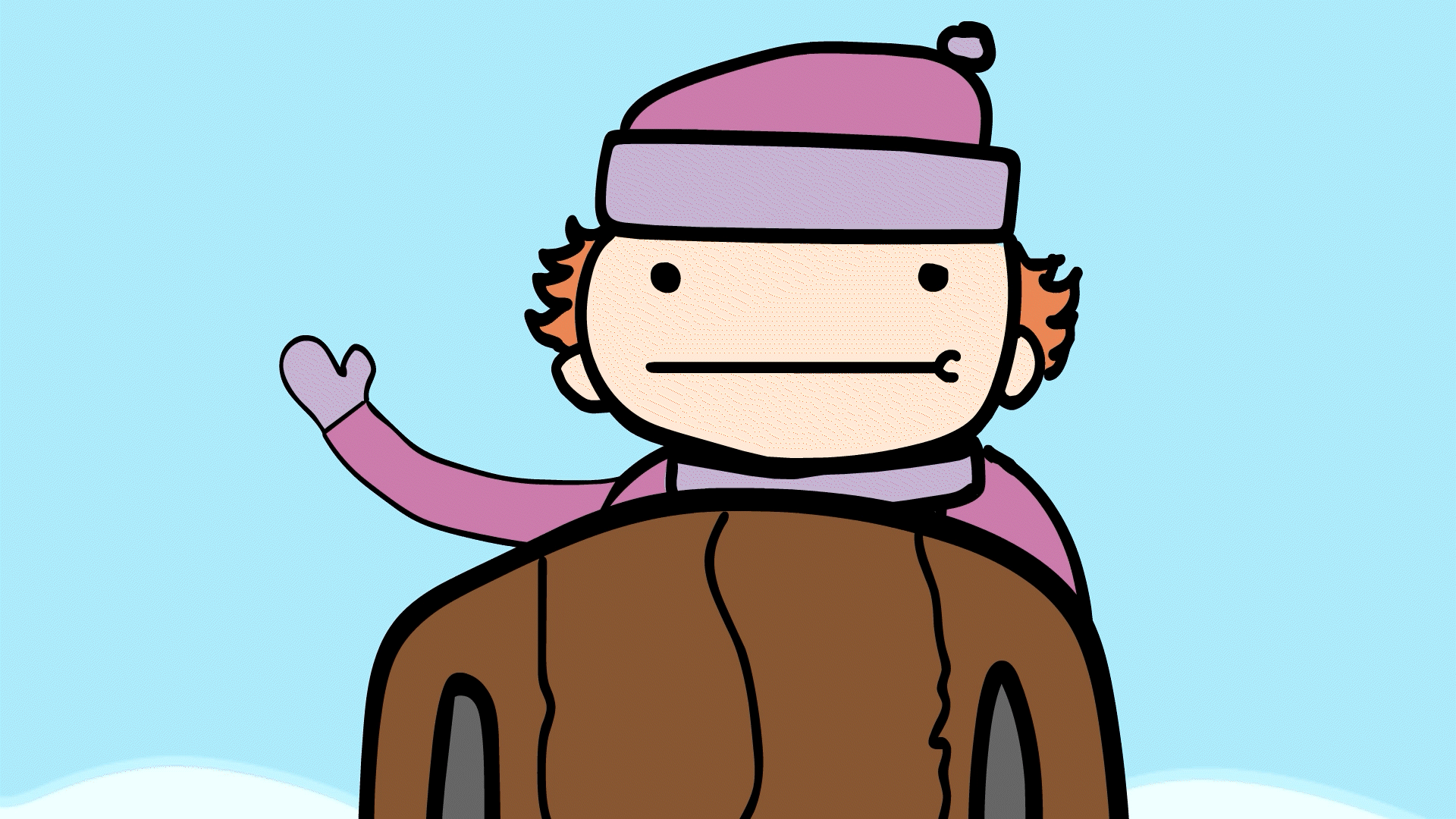
From ideation to editing, my video design project ultimately reinforces the appeal and application of animated life writing methods for sharing lived experiences. Drawing the body and designing its movements on-screen in ways that are similar to representing the body on the pages of a graphic memoir encourages additional reflection compared to simply developing a text-based script or, in the case of this project, a screenplay. During pre-production, the screenplay identifies what would be a graphic memoir’s key events with the intention to animate them during production. However, at this stage, the liveliness attributed to animation has not yet been realized. Only in drawing out the narrative, its keyframes and the in-betweens, does this “liveliness” begin to take shape. Specifically, an animator must consider how their characters visually interact with each other and their environment. Rather than relying on text, the animator is called to attend to the body, and the voice as a complement to the body, in efforts to design a meaningful account of a lived experience. Regardless of its formal design—whether the content be realistic or abstracted—the animated medium is a compelling storytelling tool that imbues a liveliness that print media cannot achieve without significant cooperation from its audience members.
Through the approach of research-creation, I have developed a narrative that plots a series of events that contribute to one of my earliest childhood memories. As with the genre of memoir, there are moments of exaggeration and embellishment, but these are the traits that make animated life writing so appealing. Using the formal method of abstraction, this animated narrative is a totality of events/decisions with uncertain and varying consequences. We may refer to this totality as what Paul Ricoeur calls incidents (21). The purpose of this video design project is to develop a narrative from a moment in a life—my life—as is the goal for any life writer. Since a life is made up of incidents, it was my goal to transform them into a single story that captures the memory that has stuck with me for so long. In what follows, I describe the process of producing an animated life writing narrative and the decisions that impacted the story’s plot and final design.
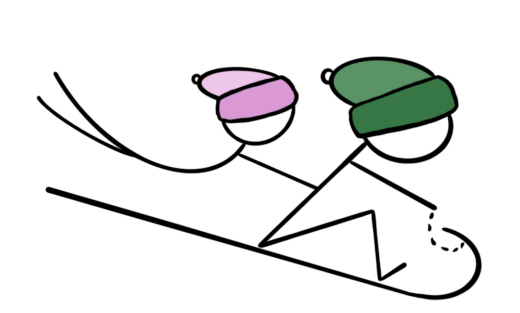
Drawing from Erin Manning’s description of Bergson’s concept of movement moving, that is, about “how movement can be felt before it actualizes,” I consider how the body exists in the physical world, how it occupies the life writer’s narrative, and, ultimately, its impact on the story and the storytelling (6).
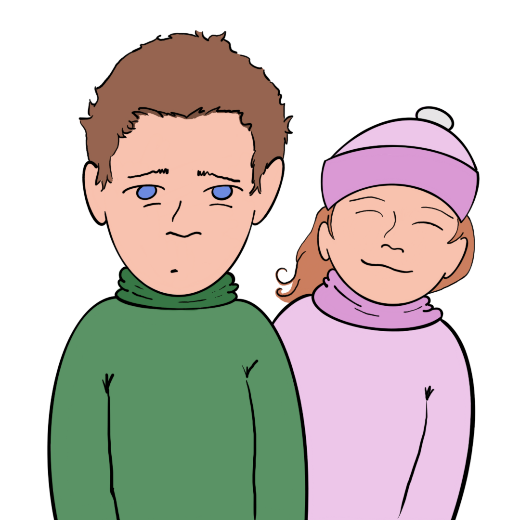
Like a choreographed dance, animation is in a process of becoming until it has been finalized. During the script writing stage, it is important to account for what is possible with the available means of production.
During the character design process, I experimented with several drawing styles to represent myself and my family. While a universal approach would be the least challenging to animate due to its lack of features, the models in Figure 6 proved to be too abstracted and would limit my ability to express emotions. However, the models in Figure 7 were too complex and would require a significant attention to detail to replicate from one frame to the next. Specifically, a 30-second story about my life, animated at 24 frames per second, meant that I had 720 individual frames to account for when designing my assets. A rotoscope-like level of realism simply would not be reasonable. Instead, my story called for simple designs that were distinguishable from each other. Afterall, it is easier for the audience to project themselves into the narrative when the characters are abstracted. Ultimately, I opted for simple hand drawn characters with limited features for my narrative (see Figure 8).
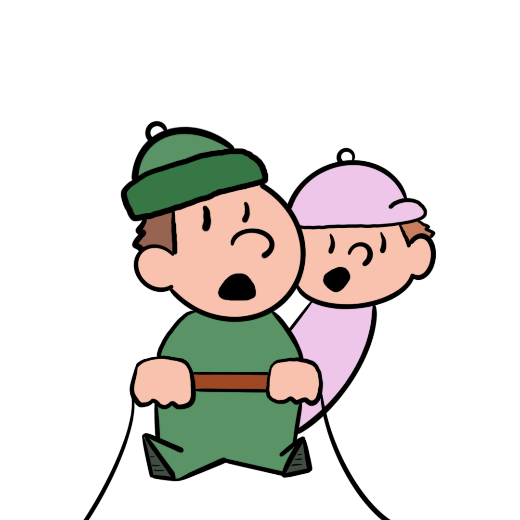
Since these narratives rely on sound just as much as they do images, this practice requires additional attention to the physical spaces that their creators occupy. What complicated the recording process in my encounter with animated life writing was my hyper-fixation on plosives and other undesirable sounds. The benefit in voice acting for my own work is that it offers me the freedom to deliver the story as I envision it. Emphasis, pauses, and inflection were all within my control—aspects not generally guaranteed in text-based narratives where readers command the pacing. All aspects of diegetic sound need to create an immersive sonic experience that does not distract the viewer from the video. This means that background noises, wild sound, and even music require additional time and attention. While I did use sound effects such as a thud at 00:01:21, I chose to limit these elements and, like in the TheOdd1sOut videos, focus on voice. This way, there is less time spent creating foley or searching online for usable content and more time on my delivery.
Because timing and on-screen movement rely on audio recordings for proper syncing, it was not until the recording stage was complete that the process of animation could begin. Voice needed to be perfected and accurately timed so that the movement on screen had an effective guide. The opposite also holds true for instances when on-screen movement is required to time the placement of sound. Take Figure 9, for example, appearing at 00:00:41. On roughly every fifth keyframe, represented by the black dots in the timeline, a thud accompanies the character hands as they hit their respective snow pile.
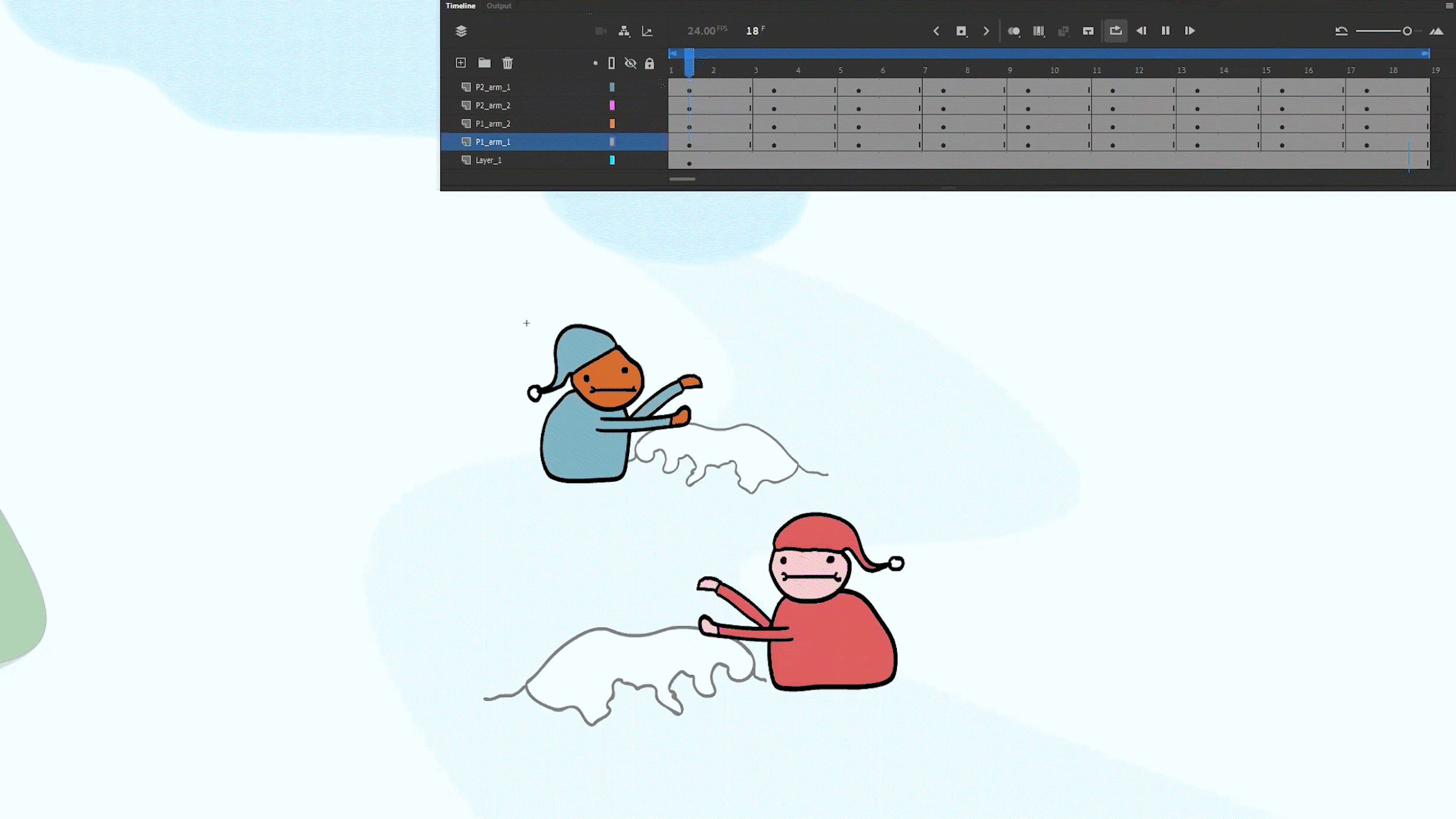
It is within this interconnected relationship between movement and sound that I observed what I consider the greatest benefit from animated life writing. Writers must think of their voice and body as extensions of the narrative—constantly informing how narrative choices dictate the delivery and design of the inanimate-turned-animate world of the cartoon. Specifically, the animated life writer is interested in how delivering one line of dialogue impacts the way a character is drawn. For example, at 00:00:41, I introduce two “big kids” building ramps at the bottom of the hill. I mention that my father had warned me about the ramps but that I was unable to grasp their significance. For this reason, the accompanying animation illustrates two children harmlessly patting snow piles with their hands. However, the animation design for this scene also informs the pacing of the story’s delivery, creating a gap in dialogue to support the narrative’s plot and comedic timing more effectively. Instead of immediately proceeding with the next line of dialogue, the viewer is given time to observe the scene before it is revealed to be an imagined event as illustrated in Figure 10. Ultimately, to craft a cohesive narrative that benefits from audio and images equally, writers are concerned with the seemingly symbiotic relationship between the dialogue’s delivery and its on-screen demonstration. Just as much as the dialogue crafts the narrative, so does the animation that supports it.
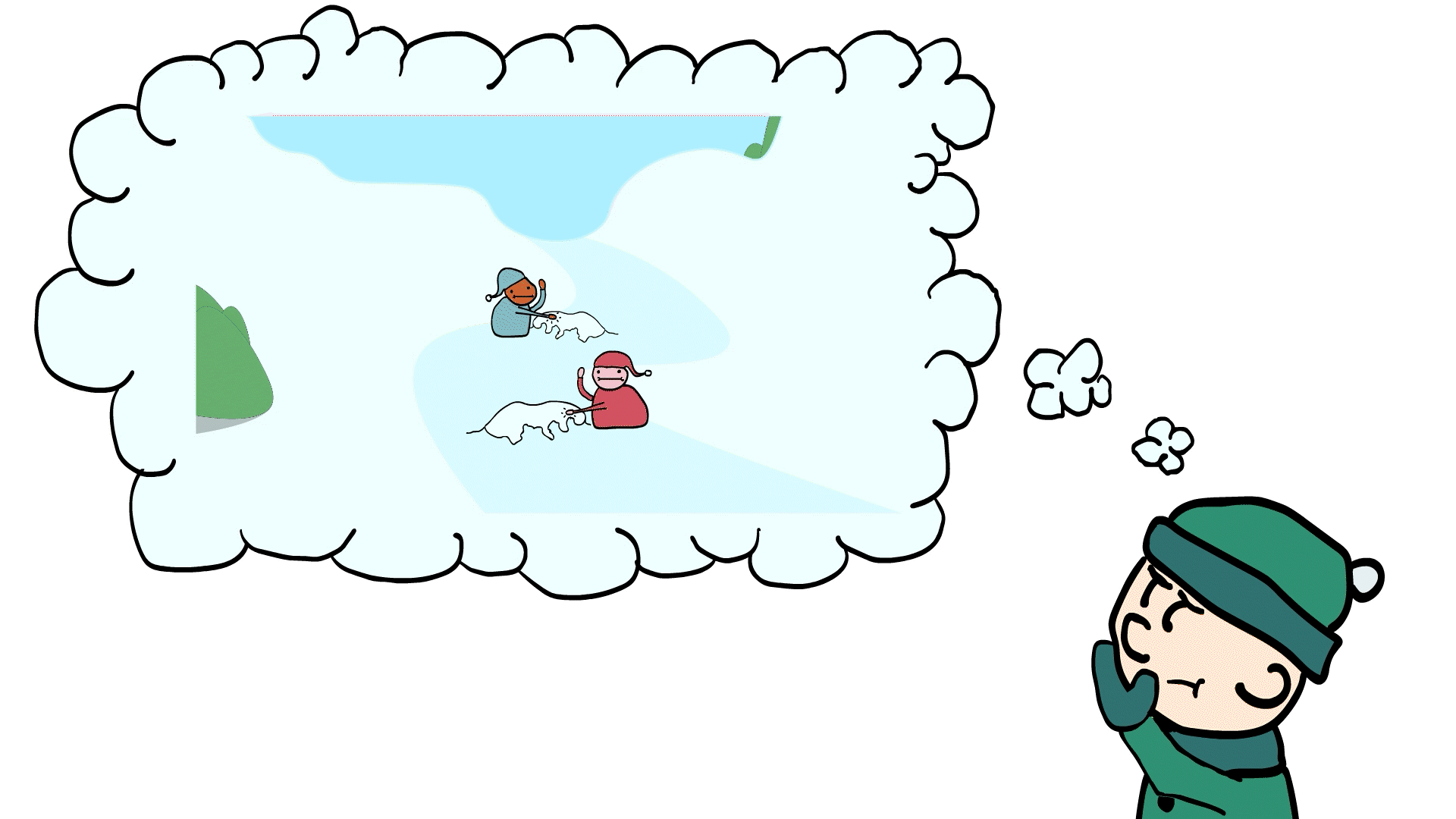
Furthermore, in rethinking our lived experiences into something that must be designed from a blank canvas, we become more attuned to our emotional connection with the story itself. As I drew my frames, I regularly thought about the aspects of the story that I wanted to represent on-screen. Given the time-consuming nature of this medium, I was compelled to share what I cared about the most. At times, this manifested more abstract concepts that I cannot put to words such as the implications of my sister blowing a kiss to our mortified father. Again, this did not happen, but it was vital for the audience to understand that she was a blissfully unaware accomplice in my act of disobedience.
Conclusion
Our digital spaces are reshaping narrative practices. When I think through graphic narrative theory, and how the visuality of texts like the graphic memoir are effective storytelling tools for life writing, I consider the animated videos that I grew up watching. Due to their increased accessibility, platforms like YouTube have cultivated communities of storytellers that engage in recognizable life writing practices. For example, while animation is distinct from static media, it still appeals to certain characteristics of comics that warrant our attention. After all, if illustrations make a text more accessible, and the cartoon uses illustrations, then surely the time-based medium of animated life writing is worthy of scholarly criticism.
This paper introduced the role of animation in current life writing trends. Content creators use this medium to story their lived experiences and some, like James Rallison, have found success because of it. I proposed then that the elements that render the graphic memoir more accessible than traditional autobiography also apply to animated life writing. For instance, as observed in comics, images in animation may be used to supplement or substitute the written word to communicate meaning more effectively. However, a robust theory of these animated practices does not yet exist, so in response my project theorizes these practices while also putting this very theory to practice, reflecting on how the creation of such animations both limits and affords new opportunities for storytellers.
Among other graphic narrative texts, like comics and the graphic memoir, animated life writing demonstrates how visual storytelling methods can be effective at sharing lived experiences. This cultural practice takes the elements of the graphic memoir and transposes them onto a timeline, imbuing it with life using sound and movement. In doing so, the author’s vision is more accurately preserved, offering an account that is more in line with their perspective. Specifically, the liveliness afforded by sound and movement reduces the viewer’s need to cooperate in the construction of a believable story. Ultimately, whether static or animated, these narratives of lived experience ought to tell their story in a manner that best captures the ideas and incidents that they represent. For some writers, a text-based social media post is enough to share their experiences. For others, the graphic memoir is their preferred format. And now, we can include the liveliness of animated life writing.
Acknowledgments
I want to express my appreciation to the Imaginations team for their guidance, enthusiasm, and support in finalizing this article.
I am equally grateful for my partner, Jesse Thompson, whose insightful feedback, and engagement with my work was endlessly valuable at all stages of writing and production.
Finally, Madison—who fell off the toboggan—I hope this makes up for it.
Works Cited
Blair, Jeremy Michael. “Animated Autoethnographies: Stop Motion Animation as a Tool for Self-Inquiry and Personal Evolution.” Art Education (Reston), vol. 67, no. 2, 2014, pp. 6-13. JSTOR, www.jstor.org/stable/24766137.
Brosh, Allie. Hyperbole and a Half: Unfortunate Situations, Flawed Coping Mechanisms, Mahem, and Other Things that Happened. New York, Gallery Books, 2019.
Couser, G. Thomas. “Is There a Body in This Text? Embodiment in Graphic Somatography.” A/b: Auto/Biography Studies, vol. 33, no. 2, May 2018, pp. 347-73. Taylor & Francis Online, https://doi.org/10.1080/08989575.2018.1445585.
DeFalco, Amelia. “Graphic Somatography: Life Writing, Comics, and the Ethics of Care.” Journal of Medical Humanities, vol. 37, no. 3, Sept. 2016, pp. 223-40. Springer Nature, https://doi.org/10.1007/s10912-015-9360-6.
Dewsbury, J. D. “Inscribing Thoughts: The Animation of an Adventure.” Cultural Geographies, vol. 21, no. 1, Jan. 2014, pp. 147-52. Sage Journals, https://doi.org/10.1177/1474474012469005.
Drąg, Wojciech. “Joe Brainard’s I Remember, Fragmentary Life Writing and the Resistance to Narrative and Identity.” Text Matters, vol. 9, no. 9, Nov. 2019, pp. 223-36. https://doi.org/10.18778/2083-2931.09.14.
Gardner, Jared, and David Herman. “Graphic Narratives and Narrative Theory: Introduction.” SubStance, vol. 40, no. 1, Jan. 2011, pp. 3-13.
Goodbrey, Daniel. The Impact of Digital Mediation and Hybridisation on the Form of Comics. University of Hertfordshire, 2017.
Kadar, Marlene. “Coming to Terms: Life Writing—from Genre to Critical Practice.” Essays on Life Writing: From Genre to Critical Practice, edited by Marlene Kadar, University of Toronto Press, 1992, pp. 3-16. JSTOR, https://doi.org/10.3138/9781442674615.
Kress, Gunther, and Theo van Leeuwen. Reading Images: The Grammar of Visual Design. 2nd ed., Routledge, 2006.
Manning, Erin. Relationscapes: Movement, Art, Philosophy. MIT Press, 2009.
McCloud, Scott. Understanding Comics. William Morrow, an imprint of Harper Collins Publishers, 2017.
Quesenberry, Krista, and Susan Merrill Squier. “Life Writing and Graphic Narratives.” Life Writing, vol. 13, no. 1, Jan. 2016, pp. 63-85. Taylor & Francis Online, https://doi.org/10.1080/14484528.2016.1130571.
Rallison, James. “Annoying Customers.” YouTube, uploaded by TheOdd1sOut, 11 April 2016, www.youtube.com/watch?v=2yFCyPX3kT0.
Rallison, James. “Sooubway 4: The Final Sandwich.” YouTube, uploaded by TheOdd1sOut, 19 Oct. 2019, www.youtube.com/watch?v=5rB7zgPlC5M&t.
Ricoeur, Paul. “Life in Quest of Narrative.” On Paul Ricoeur: Narrative and Interpretation, edited by David Wood, Routledge, 1st ed., 1991, pp. 20-33.
Taberham, Paul. “A General Aesthetics of American Animation Sound Design.” Animation, vol. 13, no. 2, July 2018, pp. 131-47. Sage Journals, https://doi.org/10.1177/1746847718782889.
Vertulfo, Mary. Animating from the Margins: Women’s Memoir and Auteur Animation as a Method for Radical Storytelling. University of Oregon, 2018.
Williams, Richard. The Animator’s Survival Kit. Expanded ed., Faber and Faber, 2009.
Image Notes
Figure 1 and 2: Brosh, Allie. “Depression Part Two.” Hyperbole and a Half, May 2013, www.hyperboleandahalf.blogspot.com/2013/05/depression-part-two.html.
Figure 3: Rallison, James. “Annoying Customers.” YouTube, uploaded by TheOdd1sOut, 11 April 2016, www.youtube.com/watch?v=2yFCyPX3kT0.
Figure 4: Rallison, James. “Sooubway 4: The Final Sandwich.” YouTube, uploaded by TheOdd1sOut, 19 Oct. 2019, www.youtube.com/watch?v=5rB7zgPlC5M&t.
Figure 5: Petryna, Brandon. “Animated Life Writing.” YouTube, uploaded by ThirdPlaceFirst, 1 Sep. 2021, www.youtube.com/watch?v=24WaFML4TjU.
Figure 6: Petryna, Brandon. 2021.
Figure 7: Petryna, Brandon. 2021.
Figure 8: Petryna, Brandon. 2021.
Figure 9: Petryna, Brandon. 2021.
Figure 10. Petryna, Brandon. “Animated Life Writing.” YouTube, uploaded by ThirdPlaceFirst, 1 Sep. 2021,
www.youtube.com/watch?v=24WaFML4TjU.